From the National Concrete Masonry Association and Sandia National Laboratories … High-power electrical discharges can trigger explosions reaching upward of 35,000°C, vaporizing steel and spewing hot metal particles. In a power plant, such high-energy arc faults can quickly spread, a condition researchers at Sandia National Laboratories, Albuquerque, N.M., are trying to prevent by finding a new way to peer into flames approximating lightning strike heat. Those flames bear useful information that can help keep power plants operating safely, researchers suggest.
|
|
| Researchers’ high-speed video footage, garnered from concrete masonry wall-shielded devices, shows a high-energy arcing fault vaporizing a steel panel on power plant equipment. VIDEO CAPTURE: Sandia National Laboratories |
Sandia fire protection and optical engineers are using high-speed cameras plus advanced algorithms, imaging and analytic methods to understand dangerous arc faults between two conductors, such as the high-voltage bus bars in power plant switch gear. For years, data from the flames proved hard to collect—until researchers tapped the temperature spike-calming potential of concrete masonry units.
To learn about the impact of an arc fault in a full range of electrical equipment with both copper and aluminum conductors, they took their commercial high-speed and infrared cameras to KEMA Laboratories in Chalfont, Pa., an independent testing facility equipped to generate high energy arc fault conditions. Investigators put the cameras behind a concrete block wall to position lenses close to the arc fault while protecting the equipment from the heat. They pointed the cameras toward high-grade mirrors and recorded the reflection of the explosion at more than 1,000 frames per second. One arc fault lasted four seconds and exhibited 26,000 amps of current. Reviewing the high-speed footage, researchers saw how a steel panel enclosing the switchgear vaporized within half a second of the arc initiation.
Power plants evaluate risks by determining arc faults’ zone of influence, the distance that neighboring cables and equipment would be damaged beyond functionality. In a nuclear power plant, such assessment helps engineers evaluate the potential of damaging the reactor core if the neighboring equipment plays a role in safely shutting down the reactor. But precise data about a rapid arc fault is hard to collect. Bright flames and smoke obscure the view, and the high heat destroys many diagnostic instruments. The electromagnetic interference associated with the flash also impairs the ability to collect data.
The large-scale tests at KEMA Laboratories involved Sandia fire protection engineers and National Institute of Standards and Technology colleagues, and were part of a Nuclear Regulatory Commission project. Researchers hope to use results to create a) a computer model that accounts for the energy, mass and momentum balances during an arc fault; and, b) a table that provides the zones of influence for a high-energy arc fault of given voltages and currents in a cabinet with specific metal conductors.
With facilities in Albuquerque, N.M. and Livermore, Calif., Sandia National Laboratories is operated by National Technology and Engineering Solutions of Sandia LLC, a wholly owned subsidiary of Honeywell International Inc., for the U.S. Department of Energy’s National Nuclear Security Administration. The organization has major research and development responsibilities in energy technologies, nuclear deterrence, global security, defense, and economic competitiveness.
